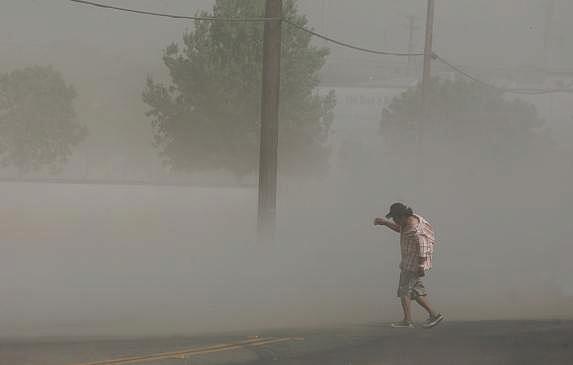Making a Difference – Together: A Reporting Collaborative Earns a CJR “Laurel”

There are many experiences worth savoring in a journalism career. There’s that first front page story, the satisfaction of obtaining a leaked report, the excitement of stepping off a plane to head out on a big international story.
Lately, I’ve had a chance to celebrate another journalism milestone – the sweetness of a great collaboration.
Next month, we mark the one-year anniversary of the “Just One Breath” series, the first project of the Reporting on Health Collaborative.
The series – which includes more than 50 stories and blog posts – chronicles the terrible toll taken by valley fever in California’s Central Valley and elsewhere in the Southwest. The reporters have produced great explainers and hard-hitting investigative stories for print, online and radio outlets, in English and Spanish. Above all, they’ve stayed with the story, provoking the kind of policy and media attention that signals that the reporting is making a difference.
Throughout it all, I’ve had the privilege of working with an extraordinary team of reporters and editors, who set aside competitive concerns for the common good.
As we got underway, we decided to make Center for Health Journalism Digital the project home. The Collaborative has become a natural extension of our professional education mission – continuing the learning that takes place through our Reporting on Health online community and in person through our professional training programs. We’ve blogged about what we’ve learned as the project unfolded and have come to see the Collaborative as a learning lab, where we can innovate in journalism and community engagement approaches.
I launched the Collaborative as a way to bring together and leverage the reporting power of the journalists we have invested in and trained over the years, with support from The California Endowment, through The California Endowment Health Journalism Fellowships at the USC Annenberg School of Journalism. The magic ingredients: the relationships we have built with newsrooms and reporters (after training more than 600 journalists nationally since 2005); support from editors; a talented and enthusiastic reporting team; and the able leadership of William Heisel, the project’s editor. Heisel, a longtime investigative journalist, has been cheerleader and guide, incisive and smart at every step. We also benefited from support, ideas and inspiration from The California Endowment’s Mary Lou Fulton, a community engagement and journalism pioneer turned media grant-maker.
The series brings together reporters and editors from seven news outlets in Central and Southern California: The Bakersfield Californian, the Merced Sun-Star, Radio Bilingue, The Record in Stockton, Valley Public Radio in Fresno and Bakersfield, Vida en el Valle in Fresno and Voice of OC in Santa Ana. Reporters working for these outlets, each with distinct newsroom cultures, came together to report, often with two or three bylines appearing on a major story.
Dave Hill, managing editor of the Merced Sun-Star and a partner, told a group of news leaders recently that when he was told about the idea for the project, he assumed the collaboration wouldn’t work. Then, he smiled suddenly, and told his peers, “But it did!”
Newsroom leaders have been generous too, providing reporting time, ideas and photographers, multimedia specialists, editors and graphic artists. It’s been a refreshing departure from the competitiveness that typically defines relationships between newsrooms as well as within them.
Trudy Lieberman, a columnist for the Columbia Journalism Review, captured the unusual zeitgeist of the Collaborative in a recent blog post: “Cooperation?” she wrote. “Not exactly what most of us were taught in J-School, but then these times they are a-changing.”
The sustained fire power and reach of seven news outlets – combined with community outreach efforts – have yielded results. Change is in the air after a year on the project.
- Kevin McCarthy, the Republican Whip in Congress, has promised to bring resources to bear on this long overlooked and devastating ailment, as the Bakersfield Californian's Rachel Cook reported.
- The Centers for Disease Control produced a study that documented the alarming rise in cases, confirming our own reporting on the undercounting of the disease and scant resources devoted to it by many members of the Collaborative (Kellie Schmitt and Rachel Cook at the Bakersfield Californian; Yesenia Amaro, then at the Merced Sun-Star; Tracy Wood at Voice of OC; Rebecca Plevin, at Vida en el Valle and KVPR, and Farida Jhabvala at Radio Bilingue).
- And national and foreign media, including the New York Times, the BBC, NPR and PBS NewsHour, have taken note, producing their own stories and adding to the momentum to address the issues.
Recently, policy makers and advocates have developed a new resolve when it comes to demanding action around valley fever. Rebecca Plevin, now a Fresno-based reporter with KVPR, recalls when she reported the story last fall for the Collaborative and Vida en el Valle about the excessive risks faced by African American inmates exposed to the disease in Central Valley prisons and documented the enormous costs to taxpayers and inmates.
The valley fever threat facing African American and immune system-compromised inmates seemed like the civil rights issue on no one’s agenda, she said, remembering the tepid responses to her calls to Amnesty International and the NAACP.
Yet when the federal receiver for California’s troubled prison health care system ordered the state to stop sending vulnerable prisoners to the Central Valley last May, the prison issues she had highlighted eight months before quickly became a national story and a rallying cry for civil rights activists.
Most journalists go into the business to do good, but sometimes public service aims get lost in the daily grind or the rush to beat the competition.
The journalists who have made this project come alive and who have brought newfound attention to a terrible disease, have a thing or two to teach us all about getting back to our journalism roots and reconnecting with our passion for making a difference.

